Woods etc
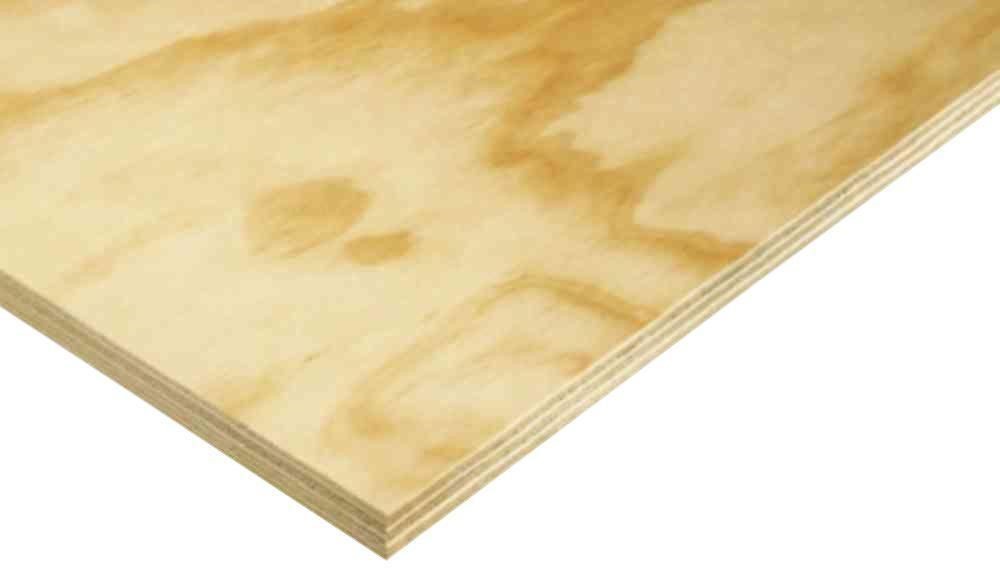
Here at Luthiery Labs, we're only interested in woods that are reasonably priced and locally available.
Wood Notes:
Since the gubment made rosewood illegal, ** despite the fact that there is no real definition of what rosewood is, alternative fretboard woods are going to become more mainstream in loothery. Bubinga is also illegal now, but that's no great loss.
** For a while, no longer
Of course, Fender has used maple for decades. Loothiers must have howled when Leo brought out the first maple Telecaster. Being a light-colored dry wood, maple needs a protective finish, unless you think grimy equals "Mojo". If you hunt around, you can often find nice pieces of flamed and/or birdseye maple hiding in the pile at regular prices. I've done enough maple fretboards, I've gotten boards with maple.
Oak makes a fine and interesting looking, if somewhat furniture-y, fretboard. The only issue is the extra work involved in filling and finishing it, as finger oils on bare oak would quickly make an ugly mess. There are lots of options for filling oak grain, you can make some interesting color combinations. One way to fill oak is simply lots of coats of brush-on poly. You can get maple and oak from the hardware store.
Walnut is supposed to be too soft for a fretboard. It works fine - so much for that bit of loothery lore. Walnut is plenty hard to hold frets. Being a dry wood, it requires some sort of finish, much like oak or maple. I would not try poplar or any type of pine for a fretboard. They might work, but with other better alternatives, why bother? Hickory is a native wood that has the requisite hardness, but an awful grain - probably more trouble than it is worth.
Brazilian Cherry or Jatoba is a terrific wood. It is common enough to be used for flooring, attractive, available (Woodcraft, Rockler) inexpensive, and very hard. The only drawback, again, is the need for a protective finish. Purpleheart is basically the same as Jatoba, but purple, although I understand that in time it becomes Brownheart. I have a couple of pieces of Bocote that look really promising. All of these tropical hardwoods would be suitable for fretless as well. The ban on rosewood may actually turn out to be a good thing. There are all kinds of good alternatives, and now we may get to see them.
For the rest of the neck, hard maple is my number one choice, and you can get perfectly good stock from the hardware store. I made two necks from poplar. I scrapped the first one for a number of reasons, not the least of which is a lack of strength. The second one was a success, in part because I altered the design to make the headstock transition stronger. If maple is available, there is no reason to use poplar. Except for the filling and finishing, oak should make just as good a neck as maple, but I have never tried it and never will. Both Radiata and Yellow Pine have specs and properties that make it attractive for a guitar neck; that is an experiment I may well try someday. Walnut also works well.
The glued-up Radiata body is an unqualified success. I built one other so far, and have more planned.
So if you want to build your first guitar, and you don't want to spend a fortune on something that might end up in the fireplace, there are lots of alternatives to overpriced "loothery" materials.
For a neck, I prefer hard maple, flamed if I can find it, from the hardware store. I have a small stock of that as well. I have even found nice birdseye on occasion. I have also experimented with poplar necks, and it is much weaker than maple and requires special design and construction to hold up in the long run - not worth the bother. I have made one neck out of walnut, and it has been very stable, but walnut is expensive stuff. For the neck, strength rather than hardness is the important quality, and hard maple wins with a modulus of 1.8. Walnut comes close at 1.7, poplar falls short at 1.6, as do lesser maples. Surprisingly, Southern Yellow Pine equals the best maple. Mahogany comes in at 1.7, but is rather brittle and prone to failure, as Gibson has proved over and over, although that is also due to bad design.
For a body, moderate hardness and light weight are desirable, as well as low cost, hence alder, ash, basswood, and my favorite for this, poplar. Strength really doesn't enter into it, any wood you use will be strong enough; hardness is just to resist dinging, a balsa-wood guitar would get pretty ugly pretty fast. Maple is heavy and expensive, and pretty much wasted in this use except as a veneer. For hollow construction, I really loves me some Masonite, and there is nothing wrong with plywood.
Wood can be a confusing subject. Granadillo is also referred to as cocobolo, which may be the same wood, or something else entirely, depending on the vendor, and it is doubtful that even they are really sure what they're selling. The 'real' African rosewood of the 1960s is long gone, but there are many dark woods sold today that are just as good if not better. Finally, not all maple is created the same. If you've ever had a Silver Maple tree on your property, you know what I mean - that is the junkiest wood I've ever seen - shedding branches continually all over until I finally got sick of it and cut it down after a hurricane broke the top clean off. You'd be better off using yellow pine, something I intend to try someday. The maple you need is 'Rock' maple, from the Sugar Maple tree. These grow agonizingly slowly, but pretty much everywhere east of the Mississippi, so if you live in the east, chances are it is the only kind you'll find at the hardware store.
You can determine if a piece of maple is suitable by calculating its density. Rock maple has a density of around 44 pounds per cubic foot, it is the densest of all the maples. To determine this, you need to take a tape measure, a postal scale, pencil and paper, and a calculator to the store. Measure the actual dimensions of the piece: ( L" x W" x T" / 1728 ) will give you the volume in cubic feet. Then weigh it and divide the weight by the volume you just calculated. If the result is significantly less than 44, it is not the right wood. I have actually done this.
Here are some relevant stats for several woods, many of which can be found at the hardware store:
White Pine:
Janka Hardness: 380 lb -- too soft
Density: 25 lb/cuft
Poplar:
Janka Hardness: 540
Density: 29
Radiata Pine:
Janka Hardness: 710
Density: 32
Maple (hard):
Janka Hardness: 1450
Density: 44 -- heavy
Red Oak:
Janka Hardness: 1220
Density: 44 -- heavy
Teak (cutting board):
Janka Hardness: 1070
Density: 41 -- heavy
Masonite (hardboard):
Janka Hardness: 1200
Density: 75
Plywood (Baltic Birch):
Janka Hardness: 1260
Density: 43 -- heavy
Also not hard to get, but not at Home Depot:
Walnut, American:
Janka Hardness: 1010
Density: 38
Black Cherry:
Janka Hardness: 950
Density: 35
Compare to typical 'luthiery' woods:
Red Alder (California firewood):
Janka Hardness: 590
Density: 28
Black Ash:
Janka Hardness: 850
Density: 34
African Mahogany:
Janka Hardness: 1070
Density: 40 -- heavy
Basswood:
Janka Hardness: 410 -- too soft
Density: 26
Korina (African construction timber, cheap and common):
Janka Hardness: 670
Density: 35
Brazilian Rosewood (now illegal):
Janka Hardness: 2790
Density: 52
For fun, here are the two extremes:
Balsa:
Janka Hardness: 67 ( styrofoam = 40 !!! )
Density: 9
Lignum Vitae:
Janka Hardness: 4390
Density: 79 ( sinks in water )
And finally, my favorite fretboard woods, which you can mail-order online in convenient sizes at reasonable prices:
Jatoba (Brazilian Cherry, flooring):
Janka Hardness: 2690
Density: 57
Bocote:
Janka Hardness: 2010
Density: 53
Purpleheart:
Janka Hardness: 2520
Density: 56
Pau Ferro ('rosewood' substitute):
Janka Hardness: 1960
Density: 54
( I have flagged all the woods I consider to be too soft or too heavy for a typical solid guitar body, although these woods may have other uses. )
This list covers most of the woods I would consider using in an electric guitar or bass. Of all these woods, there is one that you could conceivably build an entire guitar out of - body, neck, and fretboard: Hard Maple. The other major factor for wood is strength or stiffness, but all of these woods are strong enough for their usual purposes, so it doesn't matter.
Hardware Store Loothery Woods:
- Bodies - Radiata, Poplar, Masonite/plywood
- Necks - Maple, Radiata, Walnut
- Fretboards - Maple, Oak, Walnut
Random Notes:
Gibson would have you think Mahogany and Korina are rare premium woods. They are not. Mahogany is very much run-of-the-mill in many parts of the world, and Korina is construction wood in Africa, equivalent to Douglas Fir in North America. Neither one of these should command a high price, let alone the thousands of dollars that Gibson charges for some of their guitars. IMO, Mahogany is heavy, ugly, and difficult to finish, I really don't understand the attraction.
Likewise, Alder is not some magical tone elixir. Leo Fender was very cost-conscious and selected it for its price, ready availability in suitable sizes, and ease of working and finishing. Prior to this, Red Alder was considered a trash tree, used mainly for campfires. All the 'tonewood' nonsense came later. The story of Black Ash is basically the same, before it became a tonewood, it was broom handles. Both are excellent materials for guitar bodies, just not for the reasons they are now sold for.
I would consider Alder and its East Coast analog Poplar to be marginal in hardness, requiring a tough hard finish like polyurethane for protection. Thin lacquer or oil will wear or 'relic' very badly. Any wood over 40 pounds will require either a thin (1-1/4") or chambered body if you are not going to build a back-breaker. Weight ( properly density ) is unimportant for necks and fingerboards, those parts are much smaller and require strength and hardness.
Note just how soft Basswood is – unless you put it under a hard protective coat of polyurethane, it is going to wear very badly. Paulownia is even softer, basically mush – stay away! In terms of weight, maple and oak are much too heavy for a full-thickness guitar body, that is why Rics are all thin or chambered. Mahogany ( and Teak ) are on the border of too heavy. Put a Maple cap on a thick Mahogany body, and you get a boat anchor, I mean Les Paul. Oak has nothing to recommend it except possibly as a fretboard wood.
One wood that I would love to get my hands on in suitable form is "Para" or Rubber Tree wood. It is used a lot for furniture, especially Asian imports. I have never seen it used for a guitar body, but it looks promising. Teak is reviled by 'luthiers', yet I would call my experiment with it a great success.
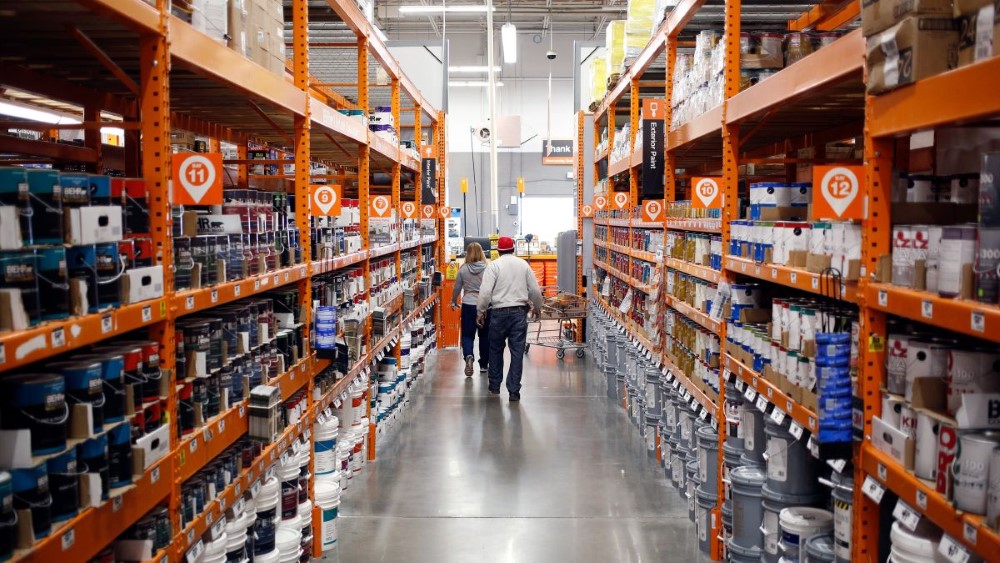
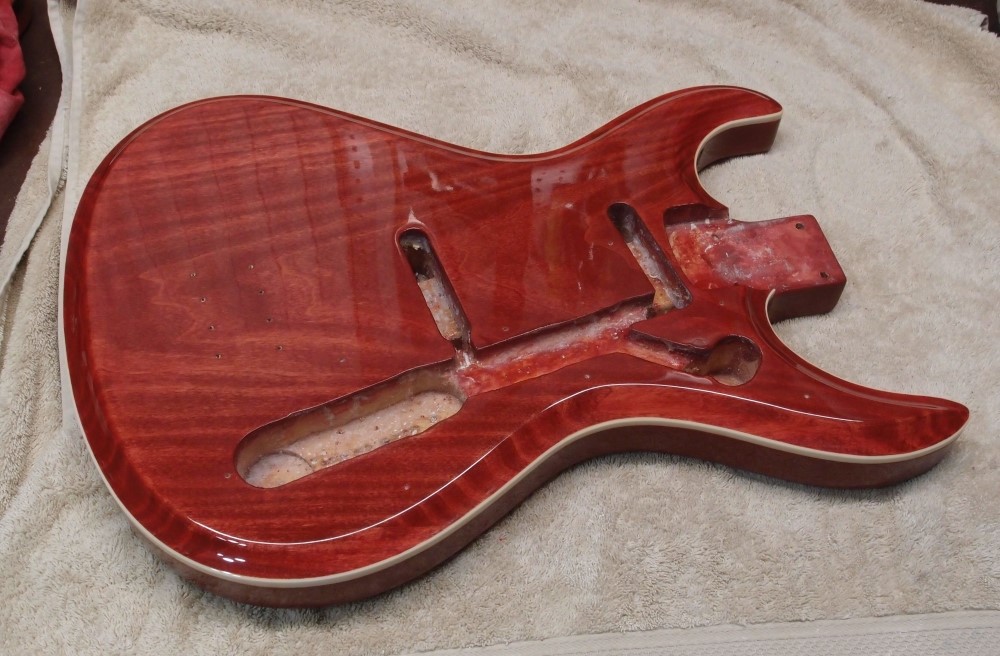
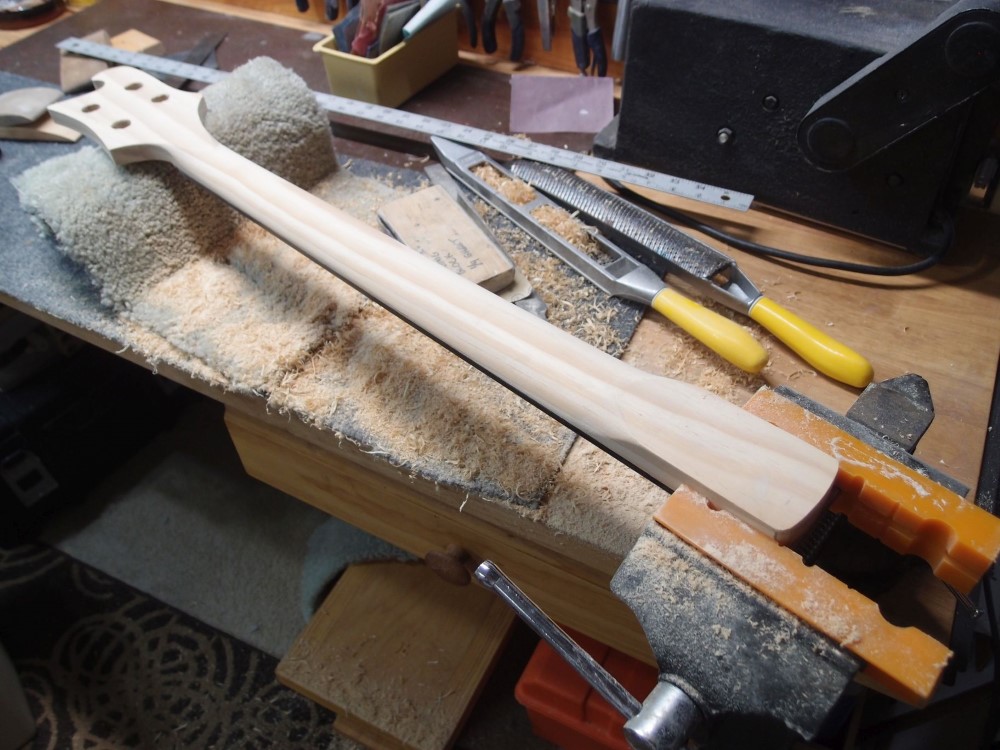
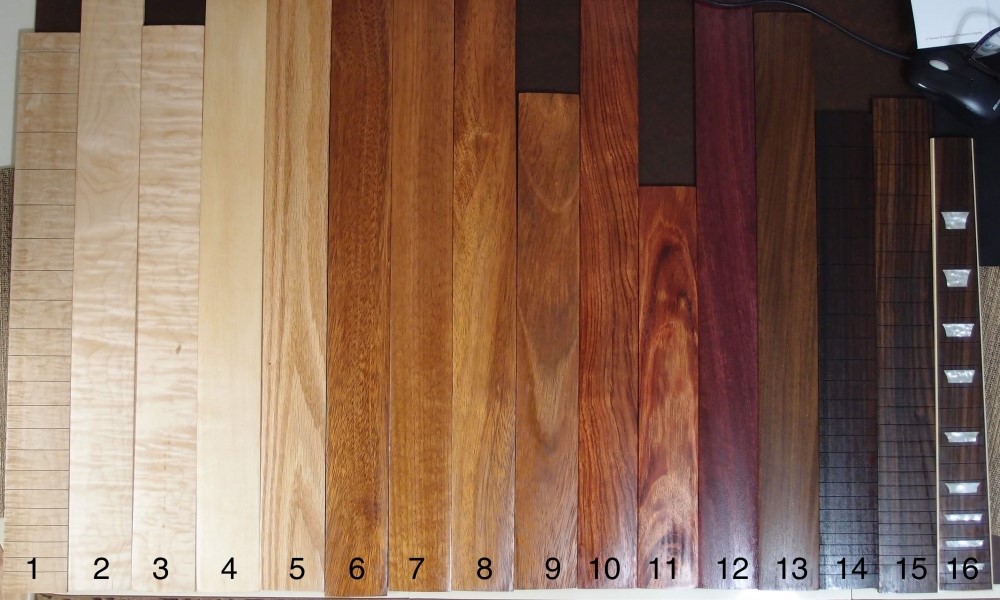




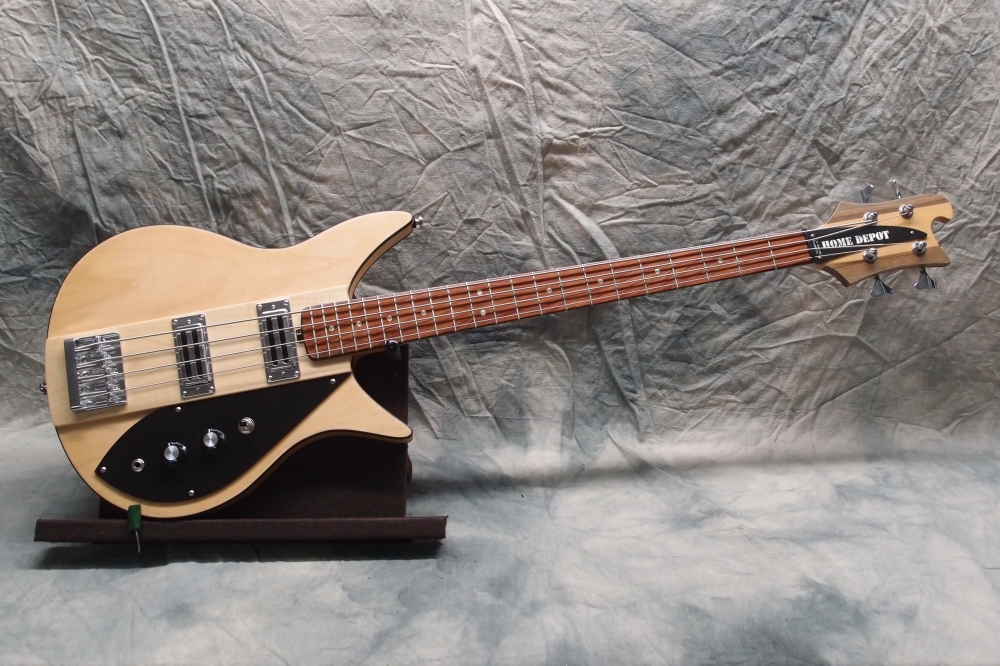


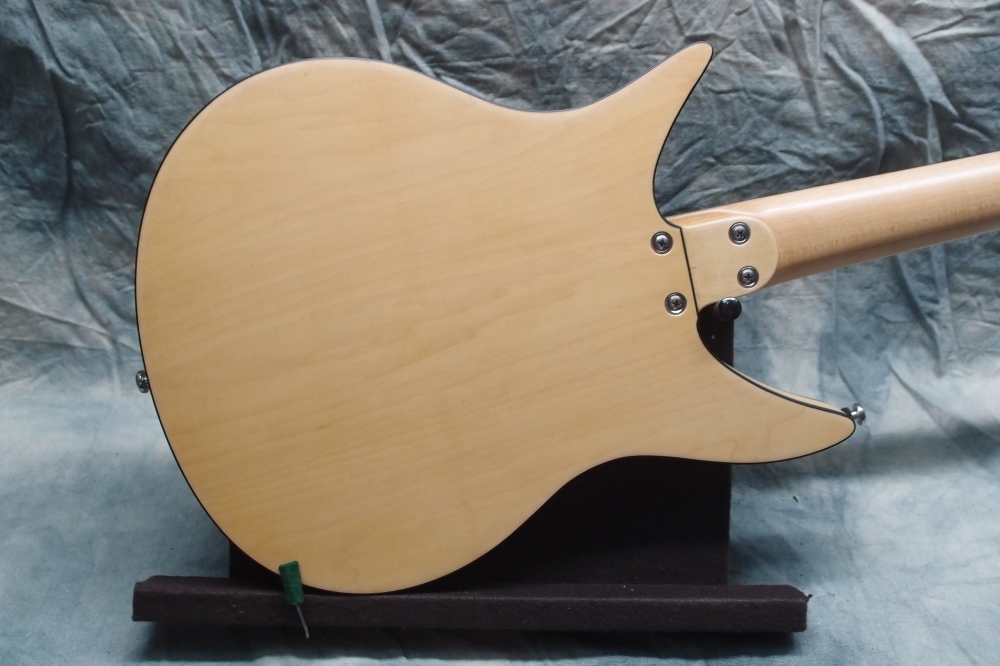

Questions or Inquiries?
Just want to say Hello? Sign the .